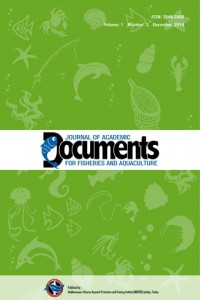Abstract
The Ecosystem Approach to Fisheries EAF has been developed in recent years in order to address the failures of fisheries management practices. FAO has devoted a considerable amount of work in bringing the principles of EAF into practical fisheries management plans. However although there are several examples around the world on the application of EAF, there is still a big misconception of what EAF actually is and how it can be applied to fisheries management. This article tries to give a short overview of the development of the EAF approach and how it can be applied in practice. EAF is basically a management planning process rooted in the principles of sustainable development and using risk assessment methodologies. It tries to balance out different societal objectives such as the resources, the ecosystem and the human dimension of fisheries. This is done through the development of a fisheries management plan with the active participation of stakeholders. The planning process goes through four main steps in order to identify the scope of the management plan, identify the issues concerned and decide which are the most important priorities and then develop the management system with several management measures. The last step involves the monitoring and review of the management measures put in place. This process, however must be developed based on the particularity of each area and fishery and that all the important stakeholders are involved from the start of the process. This is a key factor in making any fisheries management plan successful.
Keywords
References
- Bianchi G, 2008, The concept of the ecosystem approach to fisheries in FAO (In: Bianchi G, Skjoldal HR, editors, The Ecosystem Approach to Fisheries) CAB International and FAO, 363.
- Cochrane K, Garcia S 2009, A fishery manager’s guidebook. Oxford, FAO and Wiley-Blackwell. 518.
- FAO, 1995, Code of Conduct for Responsible Fisheries. Rome, Italy, 41.
- FAO, 1997, Fisheries management. Technical Guidelines for Responsible Fisheries. No 4, Rome, 68.
- FAO, 2003, The ecosystem approach to fisheries, FAO Technical Guidelines for Responsible Fisheries. Rome, 112.
- FAO, 2005, Putting into practice the ecosystem approach to fisheries, Rome, 76.
- FAO, 2012, EAF Toolbox: The ecosystem approach to fisheries, Rome, 172.
- Fletcher WJ, Bianchi G, 2014, The FAO - EAF toolbox: Making the ecosystem approach accessible to all fisheries, Ocean & Coastal Management 90, 20-26. Gezelius SS, Raakjær J, 2008, Making Fisheries Management Work: Implementation of Policies for Sustainable Fishing, Methods and Technologies in Fish Biology and Fisheries. Germany, Springer Heidleberg. 237.
- Jennings S, Kaiser MJ, Reynolds JD, 2001, Marine Fisheries Ecology. Oxford, Blackwell Scientific Publications. 417.
- Kaiser MJ, de Groot SJ, 2000, The effects of fishing on non-target species and habitats. Oxford, Blackwell Scientific Publications. 399.
- Murawski, SA, 2007, Ten myths concerning ecosystem approaches to marine resource management, Marine Policy 31, 681-690.
- Pomeroy RS, Rivera-Guieb R, 2006, Fisheries
- Co-management: A Practical Handbook. UK, CABI Publishing. 288.
Abstract
References
- Bianchi G, 2008, The concept of the ecosystem approach to fisheries in FAO (In: Bianchi G, Skjoldal HR, editors, The Ecosystem Approach to Fisheries) CAB International and FAO, 363.
- Cochrane K, Garcia S 2009, A fishery manager’s guidebook. Oxford, FAO and Wiley-Blackwell. 518.
- FAO, 1995, Code of Conduct for Responsible Fisheries. Rome, Italy, 41.
- FAO, 1997, Fisheries management. Technical Guidelines for Responsible Fisheries. No 4, Rome, 68.
- FAO, 2003, The ecosystem approach to fisheries, FAO Technical Guidelines for Responsible Fisheries. Rome, 112.
- FAO, 2005, Putting into practice the ecosystem approach to fisheries, Rome, 76.
- FAO, 2012, EAF Toolbox: The ecosystem approach to fisheries, Rome, 172.
- Fletcher WJ, Bianchi G, 2014, The FAO - EAF toolbox: Making the ecosystem approach accessible to all fisheries, Ocean & Coastal Management 90, 20-26. Gezelius SS, Raakjær J, 2008, Making Fisheries Management Work: Implementation of Policies for Sustainable Fishing, Methods and Technologies in Fish Biology and Fisheries. Germany, Springer Heidleberg. 237.
- Jennings S, Kaiser MJ, Reynolds JD, 2001, Marine Fisheries Ecology. Oxford, Blackwell Scientific Publications. 417.
- Kaiser MJ, de Groot SJ, 2000, The effects of fishing on non-target species and habitats. Oxford, Blackwell Scientific Publications. 399.
- Murawski, SA, 2007, Ten myths concerning ecosystem approaches to marine resource management, Marine Policy 31, 681-690.
- Pomeroy RS, Rivera-Guieb R, 2006, Fisheries
- Co-management: A Practical Handbook. UK, CABI Publishing. 288.
Details
| Primary Language | English |
|---|---|
| Journal Section | PUBLICATIONS |
| Authors | |
| Publication Date | August 19, 2015 |
| Published in Issue | Year 2014 Volume: 1 Issue: 3 |


